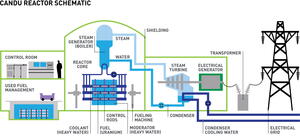Of bathtubs and laptop batteries
When presenting the promises of fusion, scientists often use this image: the energy potential contained in a bathtub filled with water (45 litres) and in the lithium of one laptop battery is equivalent to 40 tons of coal, and would provide some 200.000 kw/h of electric power. Striking—but how do you get fusion fuel, namely deuterium and tritium, from water and lithium?
"Deuterium accounts for 0.016% of water and is not very difficult to obtain", explains Manfred Glugla, ITER Division Head for Fuel Cycle Engineering. "The industry does it routinely through distillation techniques." Tritium, which is a huydrogen isotope too, is continuously produced in very small quantities in the upper atmosphere, where cosmic rays interact with nitrogen.
"Tritium's total natural inventory is 4 to 7 kilograms, to which one must add some 40 kg, left over from the atmospheric nuclear tests performed during the 60's."As tritium is a fast decaying radioelement, this "artificial" inventory will be empty in a couple of decades. But the upper atmosphere is not where the tritium for ITER will come from.
There is another source of tritium: pressurized heavy water reactors, so called CANDU reactors, who use natural uranium as fuel and heavy water as moderator. In CANDUs, tritium is a by-product of the reaction and its global inventory is presently around 20 kilos. To this safely stored "waste", ITER has opened an unexpected market: "the programme will require15 to 18 kg of tritium. Twenty years of operation will eat up the world inventory", says Manfred Glugla.
When fusion enters the industrial age, the tritium demand will be considerably higher: A fusion plant will typically require 56 kg of tritium per thermal Gigawatt per year. "Considering fusion plants will be 2 to 3 GW, this means we'll need a hell of a lot of tritium!" Where to get it? In the laptop batteries—that is, in lithium, a soft, light metal, more abundant than lead which, when interacting with neutrons, converts into tritium and helium. In ITER, this process will only be tested; in fusion plants, tritium-breeding blanket modules will be among the installation's key components. "This is another of fusion's technical challenges: it will only work if we are able to produce enough tritium inside the reactors."


